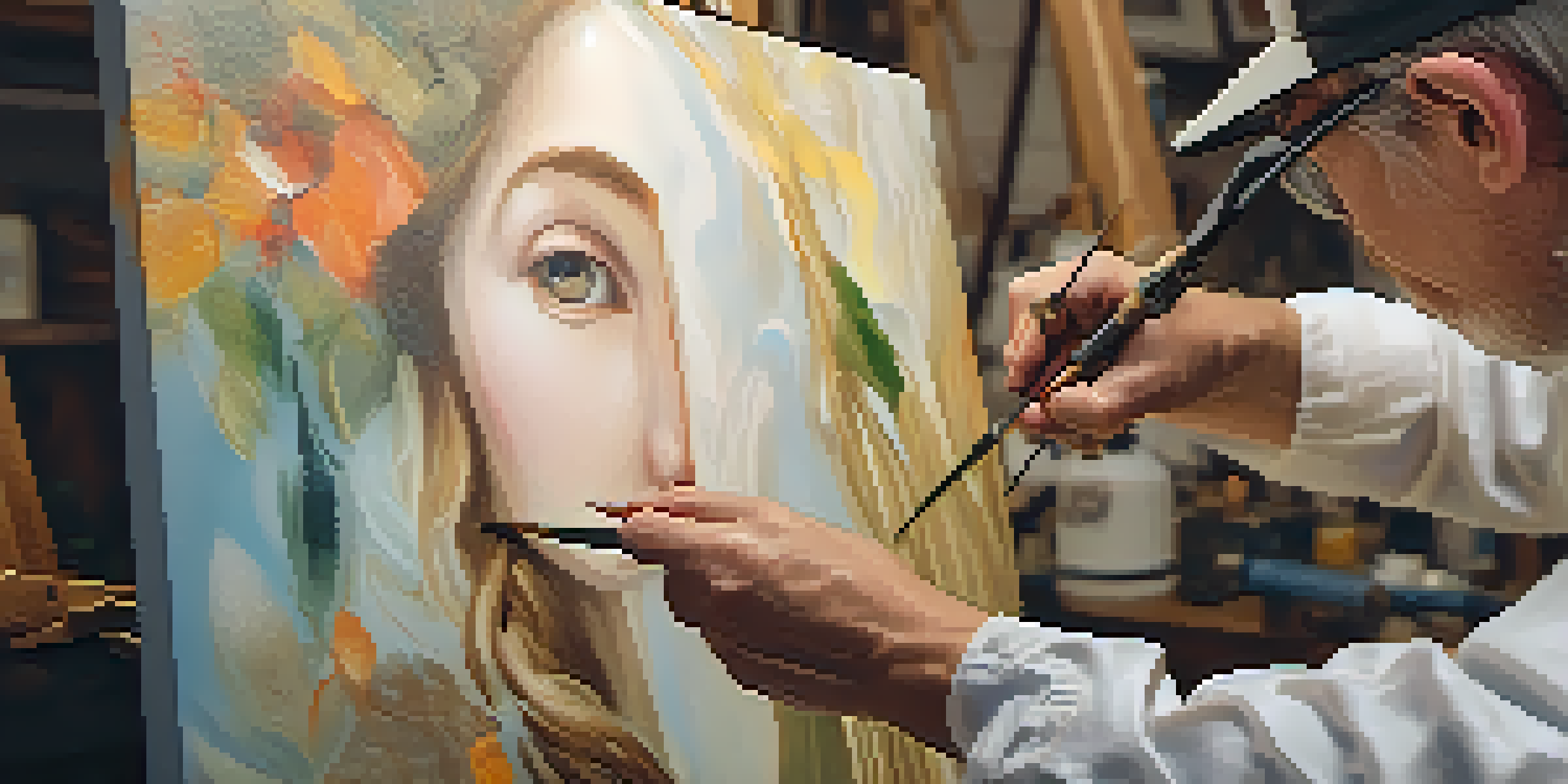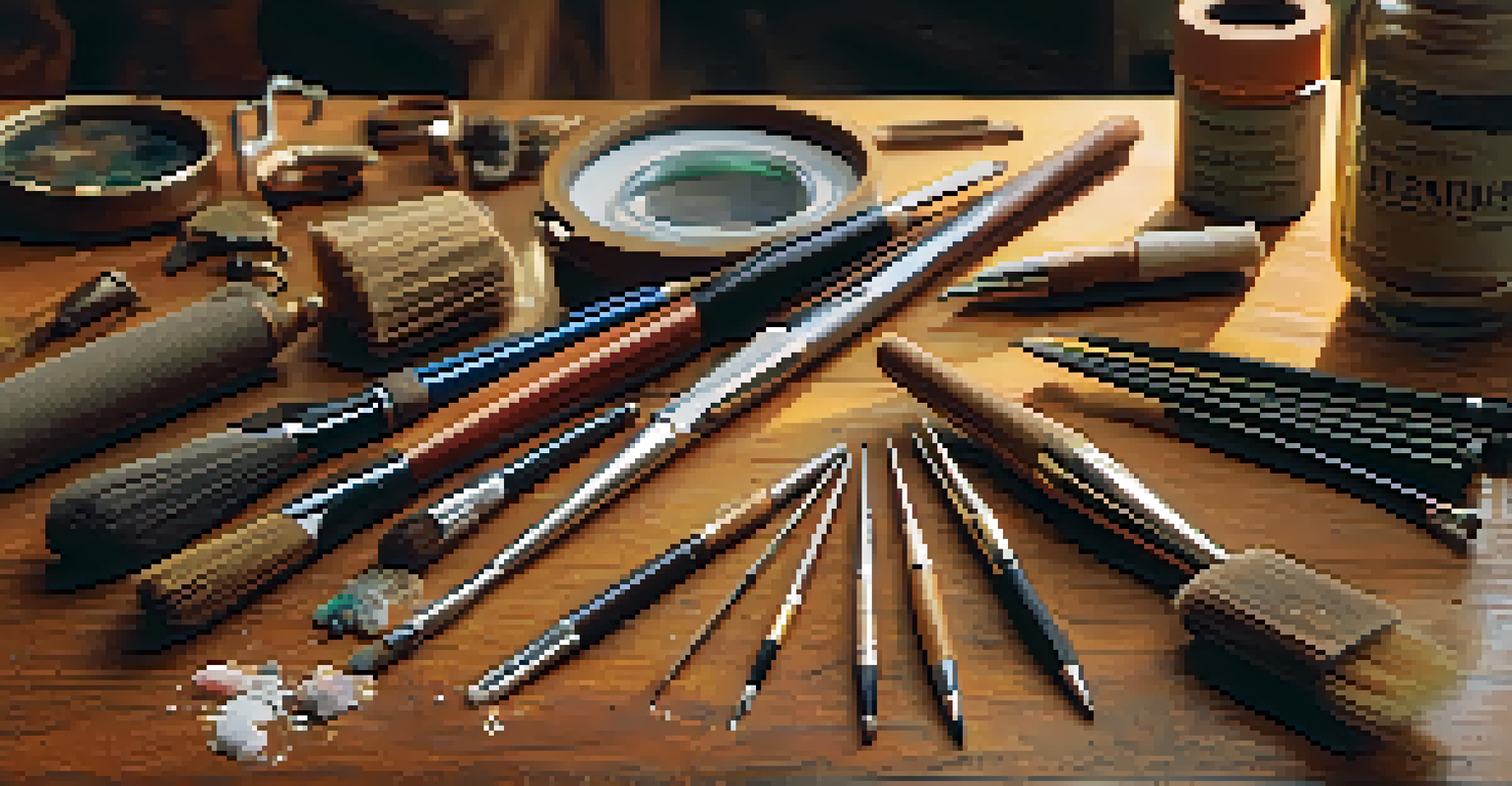Understanding Art Restoration: Techniques and Ethical Considerations

What is Art Restoration and Why It Matters
Art restoration is the process of repairing and conserving artworks to preserve their original state. This practice is essential for maintaining our cultural heritage, as many pieces of art are susceptible to damage over time due to environmental factors or physical wear. Think of it like giving your favorite book a new cover to protect the pages inside, ensuring future generations can enjoy it.
Art is not freedom from discipline, but disciplined freedom.
Restoration not only helps to safeguard artworks but also allows us to understand the artist's original vision more clearly. By carefully cleaning, repairing, or even reconstructing parts of a piece, restorers can reveal details that may have been obscured by age or damage. It's like peeling back the layers of an onion to discover the core, allowing us to appreciate the artistry involved.
However, the process of restoration is not without its challenges. It requires a delicate balance between preserving the original integrity of the piece and making it look aesthetically pleasing. This is where ethical considerations come into play, as restorers must grapple with how much alteration is acceptable without compromising the artwork's authenticity.
Common Techniques Used in Art Restoration
Restorers employ a variety of techniques to repair and conserve artworks, depending on the medium and the extent of damage. For paintings, methods like varnish removal and inpainting (filling in missing areas) are common. Imagine touching up a chipped wall with paint to match the existing color; that's similar to what restorers do with artworks.

For sculptures and three-dimensional pieces, techniques may involve cleaning, reassembling broken parts, or even using 3D printing technology to recreate missing components. This innovative approach allows for a more faithful restoration while preserving the original material as much as possible. It's akin to a surgeon using modern tools to heal a patient, focusing on recovery while honoring the patient's unique characteristics.
Importance of Art Restoration
Art restoration preserves cultural heritage and reveals the artist's original vision.
Textile restoration is another specialized area, where experts use techniques like stitching and dyeing to repair damaged fabrics. This delicate work requires not only skill but also a deep understanding of the material's historical context, much like a tailor who knows the best way to mend a cherished garment without losing its character.
The Role of Scientific Analysis in Restoration
Scientific analysis plays a crucial role in art restoration, as it helps restorers understand the materials and techniques used by the original artist. Tools such as spectroscopy and X-ray imaging can reveal layers of paint or hidden details beneath the surface. It's like using a detective’s magnifying glass to uncover clues that lead to a deeper understanding of the artwork's history.
The best way to predict the future is to create it.
By analyzing the chemical composition of pigments and binders, restorers can select appropriate materials for repairs that match the original. This ensures that any restoration work blends seamlessly with the existing artwork, preserving its authenticity. Think of it as finding the perfect shade of paint to refresh a room while keeping the overall decor intact.
Moreover, scientific analysis helps restorers make informed decisions about the best methods to use for cleaning and conservation. This knowledge is vital in preventing further damage during the restoration process, just as a mechanic uses diagnostic tools to avoid causing harm while repairing a vehicle.
Ethical Considerations in Art Restoration
Ethical considerations are at the forefront of art restoration, as restorers must navigate the fine line between preservation and alteration. The primary goal is to maintain the artwork's integrity, which can sometimes lead to conflicting opinions on how much intervention is appropriate. It's like deciding how much to change a family recipe while still honoring the original flavors.
Restorers often adhere to a set of professional guidelines that emphasize minimal intervention and transparency about the restoration process. This means that any repairs made should be reversible, and the methods used should be documented thoroughly. Imagine a chef keeping a detailed journal of their cooking techniques to preserve the authenticity of their dishes.
Techniques in Art Restoration
Restorers use various methods like inpainting and 3D printing to repair and conserve artworks.
Additionally, ethical dilemmas can arise when dealing with pieces that have undergone significant damage or alterations over time. Restorers must carefully consider whether to restore the piece to its original state or preserve its history, much like choosing between restoring an old car to its factory condition or leaving it with its unique wear and tear as a testament to its journey.
Case Studies: Successful Art Restorations
One notable example of successful art restoration is the restoration of Leonardo da Vinci's 'The Last Supper.' Over the years, this masterpiece suffered extensive damage due to environmental factors and poor restoration attempts. The meticulous work done by restorers not only preserved the painting but also revealed da Vinci's original colors and details, akin to uncovering a hidden treasure.
Another inspiring case is the restoration of the Sistine Chapel's frescoes, which involved cleaning centuries of grime and soot. The process revealed vibrant colors and intricate details that had been obscured for years. This restoration serves as a reminder of the importance of preserving our cultural heritage, just as a gardener nurtures plants to bring out their natural beauty.
These case studies highlight the transformative power of art restoration, demonstrating how skilled professionals can breathe new life into damaged artworks. They remind us that, much like a skilled craftsman, restorers have the ability to restore not just the physical aspects of a piece but also its emotional resonance.
The Future of Art Restoration: Innovations and Challenges
As technology continues to advance, the future of art restoration looks promising. Innovations such as virtual reality and artificial intelligence are beginning to play a role in the restoration process, offering new ways to visualize and analyze artworks. Imagine being able to step inside a painting and see its layers in real time; this could revolutionize how restorers approach their work.
However, these advancements also present challenges, particularly concerning the ethical implications of using technology in restoration. Restorers must grapple with questions about authenticity and the potential for over-reliance on machines rather than traditional techniques. It's a bit like a musician using auto-tune; while it can enhance a performance, it may also detract from the raw talent of the artist.
Ethics in Restoration Practices
Restorers face ethical challenges in balancing preservation with necessary alterations to artworks.
Additionally, the art world must address issues of accessibility and conservation funding as these technologies become more prevalent. Ensuring that all restorers have access to the latest tools and training is crucial for maintaining the integrity of the profession. Much like a community working together to build a library, a collaborative approach will help safeguard our shared cultural heritage.
How You Can Support Art Restoration Efforts
Supporting art restoration efforts is easier than you might think! One of the most impactful ways you can contribute is by donating to museums and cultural institutions that focus on conservation. These organizations rely on public support to fund restoration projects, much like a coach relies on team spirit to motivate players.
You can also get involved by attending exhibitions, workshops, or lectures that highlight the importance of art restoration. By educating yourself and others about the value of preserving our cultural heritage, you help raise awareness and appreciation for this vital work. It’s similar to spreading the word about a fantastic local restaurant; the more people know, the more support it receives.

Lastly, consider volunteering your time or skills to support local art initiatives. Whether it’s helping at an event or participating in community restoration projects, your efforts can make a significant difference. Just as every small act counts in making a difference in a community, your involvement can help preserve the rich tapestry of our artistic legacy.